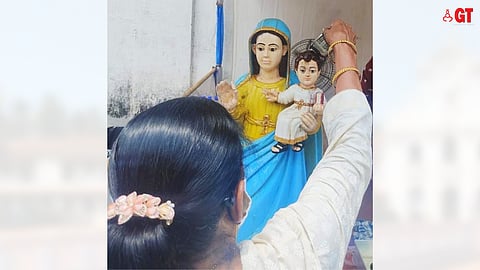

When it comes to stocking up the Goan kitchen with culinary essentials, Mapusa is perhaps the best place to shop. But, if you thought that the only thing you can do in Mapusa is go shopping, you would be sadly mistaken!
Mapusa has its fair share of festivals, and at this time of the year, one of the biggest feasts in Bardez is held in this town.
SISTERS & CELEBRATIONS
The feast of Our Lady of Miracles (Nossa Senhora dos Milagres) is celebrated at the Milagres Church (Igreja de Nossa Senhora dos Milagres), in Mapusa, on the second Monday after Easter.
An interesting feature of this feast is that, both, Catholics as well as many of Goa’s Hindus venerate Our Lady of Miracles. For Hindus, Milagres Saibinn is the incarnation of goddess Mirabai, who is the sister of goddess Lairai.
The zatra of goddess Lairai is celebrated at Shirgao on Vaishak Shudda Panchami day, which is around the time of the feast of Our Lady of Miracles.
ACCORDING TO FOLKLORE
According to local lore, Milagres Saibinn is one of seven sisters. She had been converted to Catholicism by the Portuguese colonialists.
Her other sisters, who are worshipped in temples across Goa, are Lairai (at Shirgao), Mahamaya (at Mayem), Kelbai (at Mulgao), Monai (at Morjim), Ajadipa (Anjadiv) and Shitala (Patala).
Khetoba is their only brother and is worshipped in Vaiganim.
Milagres Saibinn was initially known as Nossa Senhora de Todos os Bens (Our Lady of all Blessings). Since many miracles were attributed to her, she soon came to be known as Milagres Saibinn (Our Lady of Miracles).
ABOUT THE CHURCH
Milagres Church, also known as Mapusa Church or St Jerome's Church, was built by the villagers of Mapusa, Cunchelim and Khorlim in 1594. It was rebuilt several times over the course of the next 200 years.
On the eve of the feast day, in 1838, there was a major fire, believed to have been caused by a candle which was left on the main altar during the night. As a result, the church was destroyed and the feast mass had to be celebrated in the newly-built cemetery. But, the gaunkars of Mapusa, Khorlim and Cunchelim rose to the occasion and the church was eventually rebuilt.
FESTIVE TRADITIONS
On the feast day, two statues are kept for veneration in the church – one is meant for the oil bath (generally done by Hindu devotees), while the other is meant for flowers, candles etc, offered by Catholics, whose prayer requests have been fulfilled.
An interesting tradition followed during the feast is the exchange of ojem (gifts) by the two sisters – Lairai and Milagres. During this exchange, Lairai ‘sends’ a couso (pot) of coconut oil to Milagres on the feast day; and a few days later, Milagres ‘sends’ a basket of jasmine flowers (mogrim) to her sister during the zatra.
According to popular legend, the sisters visit each other on the day of their respective festivals. And, in the rare event that the feast day and zatra occur on the same day, the sisters will not be in a position to visit each other, resulting in some misfortune.
Incidentally, the fire of 1838, when the Mapusa Church was destroyed on the vespers night, was one of those rare times when, both, the feast and zatra occurred on the same day.